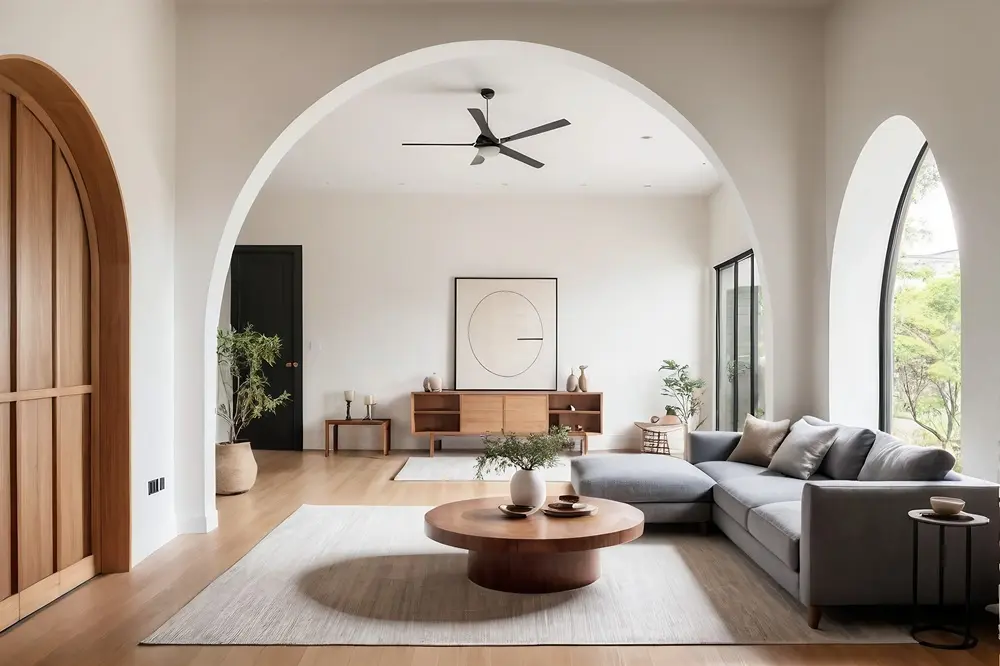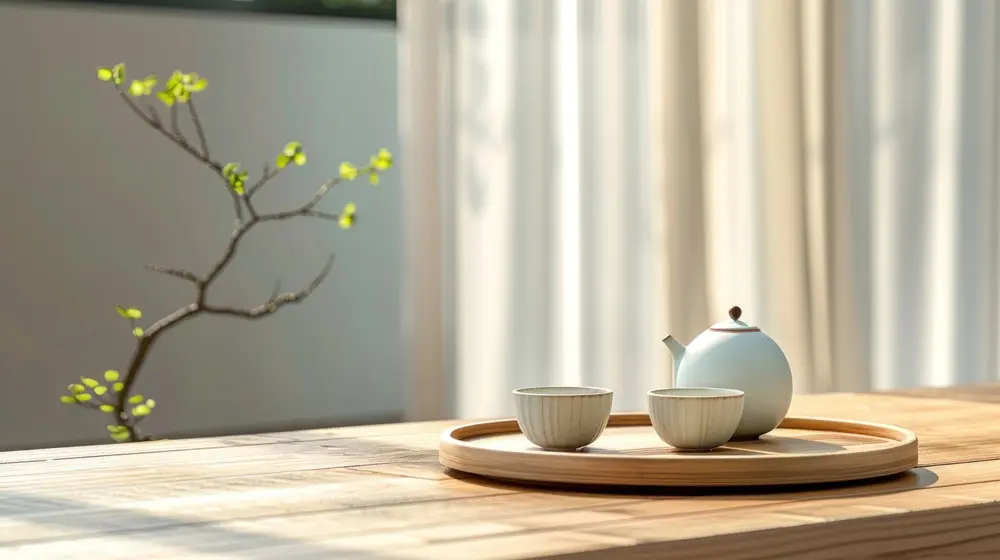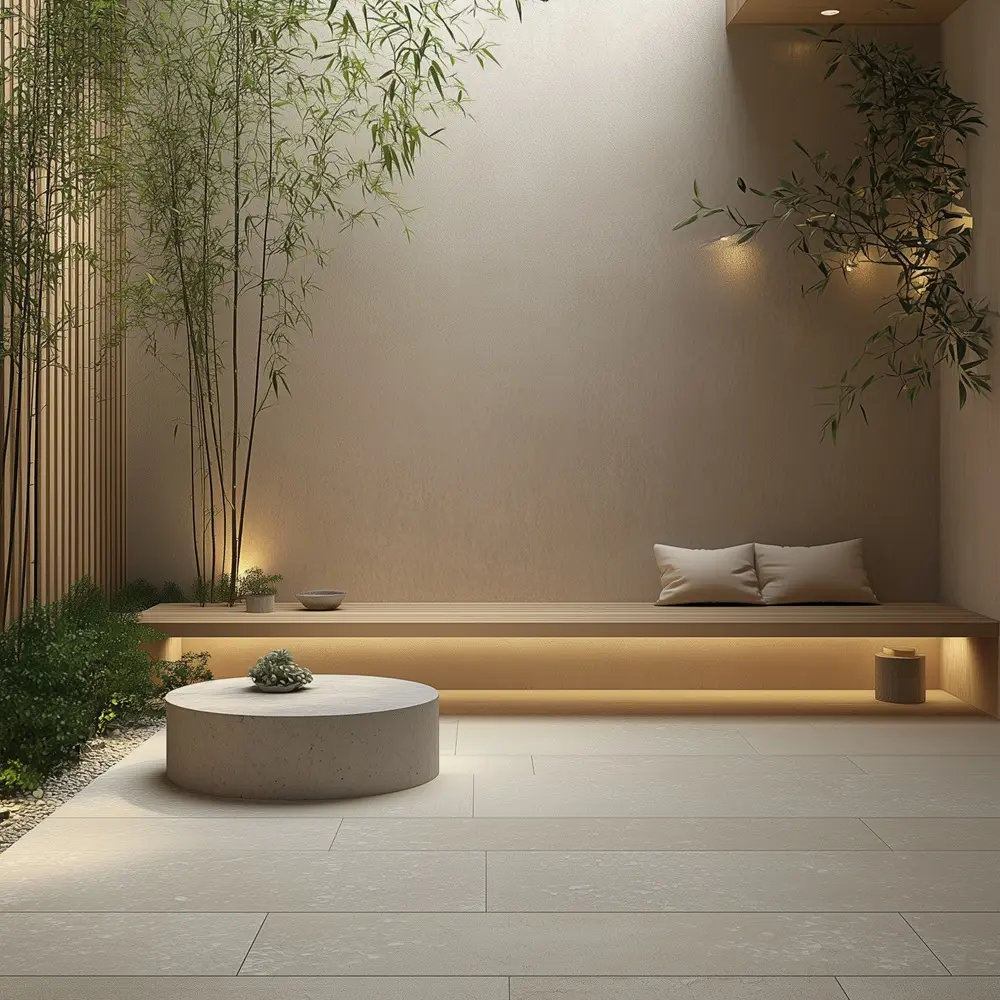5 Japandi House Trends 2025: Minimalist Design Meets Smart Living and Sustainable Choices

In 2025, Japandi interior design continues to evolve, seamlessly blending Japanese minimalism with Scandinavian functionality while embracing the demands of modern living. This year, the focus extends beyond aesthetics, integrating smart technology, eco-conscious materials, and multifunctional spaces to create homes that are sustainable and highly efficient.
As homeowners prioritize well-being, energy efficiency, and adaptability, Japandi interiors are redefining the balance between tradition and innovation. Discover the defining Japandi house trends of 2025, where modern technology seamlessly integrates with minimalist design, and every space is crafted with mindfulness and purpose.
The Evolution of Japandi Homes in 2025
Japandi homes in 2025 blend smart technology with sustainable materials to create spaces that prioritize well-being, functionality, and environmental consciousness. Integrating energy-efficient appliances, smart lighting, and nature-inspired design, these homes embrace minimalism while being adaptable to modern lifestyles.
Eco-friendly materials like reclaimed wood, bamboo, and upcycled furniture embody mindful living and wabi-sabi principles, while smart home features such as automated lighting and climate control enhance convenience. Drawing inspiration from Scandinavia's advanced sustainable housing and city planning, Japandi design seamlessly merges aesthetics, technology, and sustainability, evolving from a trend into a lifestyle of harmony, simplicity, and innovation.
5 Key Japandi House Trends in 2025
1. Sustainable Japandi
Sustainability is a core pillar of Japandi interiors in 2025, emphasizing eco-conscious materials, energy efficiency, and harmonious indoor-outdoor living.
Natural & Reclaimed Materials
Japandi homes prioritize reclaimed wood, bamboo, cork, rattan, and organic textiles, embracing the wabi-sabi philosophy of caring for and preserving things over time. These elements add warmth, texture, and character, reinforcing a connection to nature while reducing environmental impact. Handmade, upcycled, and vintage pieces further align with this ethos, promoting mindful consumption.
Energy-Efficient Design
Modern Japandi homes prioritize energy efficiency, using passive house design principles to improve insulation and reduce energy waste. Homes incorporate solar panels, smart lighting, and water-saving fixtures like low-flow faucets and rainwater collection systems.
High-performance insulation and cross-ventilation further optimize natural cooling, ensuring comfort while minimizing energy consumption. These innovations create eco-friendly, cost-effective living spaces that align with Japandi's ethos of sustainability, simplicity, and functionality, blending smart technology and minimalism.
Non-Toxic & Sustainable Finishes
To support healthier indoor air quality and well-being, Japandi homes incorporate non-toxic, sustainable finishes. VOC-free (volatile organic compounds) paints, natural clay walls, and non-toxic wood treatments minimize harmful emissions while preserving material integrity. Eco-friendly flooring options like cork and bamboo offer durability and biodegradability, ensuring a harmonious balance between aesthetics and sustainability. These thoughtful choices create safe, breathable, and environmentally responsible living spaces that align with Japandi's commitment to mindful, health-conscious design.
Indoor-Outdoor Connection & Sustainable Landscaping
Japandi homes emphasize seamless indoor-outdoor connections, fostering a tranquil, nature-inspired living environment. Expansive windows and open courtyards maximize natural light and ventilation, while sustainable gardens with native plants minimize water usage. Zen-inspired patios and rock gardens enhance serenity and eco-friendly design, blending aesthetics with functionality. This harmonious integration of nature and architecture reinforces Japandi's core principles of simplicity, sustainability, and mindfulness, creating peaceful retreats that promote well-being and a deep connection to the natural world.
2. Minimalist Smart Japandi Homes
In 2025, Japandi homes seamlessly integrate smart technology that enhances efficiency and convenience while preserving their serene, minimalist aesthetic. By integrating smart solutions that prioritize efficiency, comfort, and sustainability, homeowners can enjoy a space that is both beautifully tranquil and highly functional.

AI-Powered Lighting for Effortless Ambiance
In modern Japandi homes, AI-controlled lighting systems adjust brightness and color temperature based on natural rhythms. During the day, cooler tones mimic daylight to promote focus and productivity, while in the evening, warm hues create a cozy and relaxing atmosphere. Motion-sensor lights, hidden LED strips, and dimmable smart bulbs further enhance convenience while maintaining a clutter-free aesthetic.
Smart Climate Control for Year-Round Comfort
Automated climate control systems regulate indoor temperatures in response to environmental conditions, ensuring optimal comfort without excessive energy consumption. Smart thermostats adapt to personal preferences and seasonal changes, maintaining warmth in winter and a refreshing coolness in summer. Additionally, air-purifying systems with natural filtration, such as charcoal and HEPA filters, help maintain indoor air quality while complementing the natural ethos of Japandi living.
Voice-Activated Assistants for Seamless Minimalism
With voice-activated assistants integrated into Japandi homes, daily tasks become effortless. Smart speakers discreetly tucked into bookshelves or wooden panels allow homeowners to control lighting, play soft ambient music, adjust the thermostat, or even access meditation guides--all while maintaining the serene atmosphere of the space. These assistants help streamline household functions without the need for excessive gadgets or visible tech clutter.
Hidden Smart Technology for a Clutter-Free Space
Smart technology is seamlessly integrated into furniture and storage solutions. Hidden charging stations, sensor-driven storage compartments, and multi-functional furniture with built-in tech help keep surfaces clear and organized. Wireless charging pads discreetly embedded into wooden side tables and retractable projector screens that disappear when not in use further contribute to the uncluttered aesthetic.
3. Evolving Japandi Color Palette & Materials
While Japandi interiors have traditionally been defined by neutral color schemes, 2025 sees a refined evolution, introducing warm, earthy hues and deeper contrasts to enhance depth and character.

A Shift Toward Warm Neutrals
The classic Japandi palette of whites, beiges, and soft grays is expanding to include taupe, clay, warm browns, greens, and earthy terracotta. These tones are applied in accent walls, textiles, ceramics, and upholstery, enriching spaces while maintaining the natural harmony intrinsic to Japandi aesthetics.
The Rise of Darker Tones
To create a grounded, sophisticated ambiance, Japandi interiors incorporate black, charcoal, and deep brown accents more prominently. Whether through wood finishes, metal fixtures, or statement furniture, these darker elements provide visual contrast, balancing the inherent lightness of Scandinavian-inspired spaces with the depth and richness of Japanese design.
Textural Variety for Depth & Character
Japandi homes embrace textured materials to add warmth without disrupting minimalism. Natural stone, linen, woven textiles, and raw wood introduce subtle visual interest, ensuring the space remains inviting and tactile. Handcrafted ceramics and rattan details further enhance the organic feel, reinforcing Japandi's connection to nature.
Soft, Muted Accents for Personality
Rather than bold splashes of color, Japandi interiors incorporate subtle, nature-inspired hues like dusty rose, sage green, and ochre to complement neutral backdrops. These shades appear in cushions, artwork, and decorative objects, infusing spaces with personality while preserving a calm, balanced atmosphere.
4. Flexible & Multifunctional Japandi Spaces
Japandi interiors in 2025 emphasize adaptability and efficiency, catering to the evolving needs of modern homeowners. With urban living spaces becoming increasingly compact, flexibility in design is essential to maintaining functionality without sacrificing aesthetics.

Hybrid Home Offices & Relaxation Zones
The rise of remote work has led to the evolution of Japandi-inspired home offices, where work-life balance is seamlessly incorporated. Minimalist workspaces feature warm wood tones, ergonomic furniture, and soft lighting, while designated relaxation areas such as reading corners with floor cushions allow homeowners to unwind within the same space.
Urban Minimalism & Space Optimization
For compact city dwellings, Japandi design maximizes space without overcrowding. Lofted beds with built-in storage, convertible sofa-beds, and wall-mounted shelving free up floor space, maintaining an open, airy feel. Inspired by the Japanese concept of "ma" (negative space), these layouts emphasize breathing room while remaining highly practical.
Modular & Transformable Furniture
Space-saving, modular furniture such as foldable dining tables, extendable work desks, and stackable seating allow rooms to shift between work, relaxation, and entertaining guests. Built-in storage seamlessly integrates into furniture, reducing clutter and preserving the minimalist aesthetic.
Movable Partitions for Fluid Spaces
Sliding shoji-style partitions, folding screens, and retractable walls create versatile interiors that can expand or contract as needed. A living room may transform into a workspace during the day or an intimate dining area at night, ensuring every square meter serves a purpose.

5. Japandi-Inspired Wellness Spaces
As the need for balance and tranquility grows, Japandi interiors in 2025 prioritize wellness-focused spaces that nurture both mental and physical well-being. These spaces integrate nature, mindfulness, and sensory comfort, transforming homes into personal sanctuaries.
Nature-Infused Corners for Serenity
Nature-focused design plays a vital role in Japandi-inspired wellness spaces, with homeowners integrating indoor plants, water features, and organic materials to create a stronger connection to nature. Small rock gardens, moss walls, and cascading greenery bring a touch of the outdoors inside, reinforcing a sense of tranquility. Large windows that frame natural views or sliding shoji screens that open to gardens further blur the boundary between indoor and outdoor living.
Meditation & Mindfulness Nooks
Japandi homes incorporate dedicated meditation corners featuring low-seating arrangements, tatami mats, and floor cushions to promote relaxation. Natural light, subtle ambient sounds, and soft textures create an atmosphere conducive to mindfulness practices, yoga, or quiet reflection. Minimalist shelving with neatly arranged books, handcrafted ceramics, and a single bonsai or ikebana arrangement enhances the calming effect.
Spa-Like Bathrooms for Relaxation
Bathrooms in Japandi homes embrace a spa-inspired aesthetic, using natural materials, soft lighting, and minimalist design to create a restorative retreat. Hinoki wood bathtubs, known for their soothing aroma and antibacterial properties, provide a traditional Japanese bathing experience, while stone basins and rainfall showers evoke the simplicity of Scandinavian spas. Warm, indirect lighting and scented candles with notes of cedar, sandalwood, or yuzu enhance the relaxation ritual.
Aromatherapy & Sensory Comfort
Japandi wellness spaces appeal to the senses through natural textures, calming scents, and soft color palettes. Aromatherapy diffusers with essential oils like lavender, eucalyptus, or hinoki add a subtle yet invigorating scent to the air. Linen curtains, woolen throws, and handcrafted clay pottery introduce tactile comfort, while earthy tones such as beige, warm taupe, soft greens help create a serene atmosphere.
Versatile Wellness Spaces
Well-being is seamlessly integrated into daily life with versatile wellness spaces that serve multiple functions. A sunlit alcove doubles as a meditation area and reading nook, while a compact Japanese-style tea corner with handcrafted ceramic teapots and tatami flooring offers a mindful escape. Folding screens and modular furniture ensure these areas can adapt to changing needs, embodying the Japandi principle of functional simplicity.

The Future of Japandi Living

Japandi house trends in 2025 showcase a refined balance between sustainability, smart living, and functional beauty. The movement proves that minimalism is not just about reducing clutter, it is about curating a home that fosters mindfulness, adaptability, and eco-conscious choices.
As the world moves toward more thoughtful, efficient, and nature-connected living, Japandi remains a timeless yet forward-thinking design philosophy that continues to inspire modern homes.



